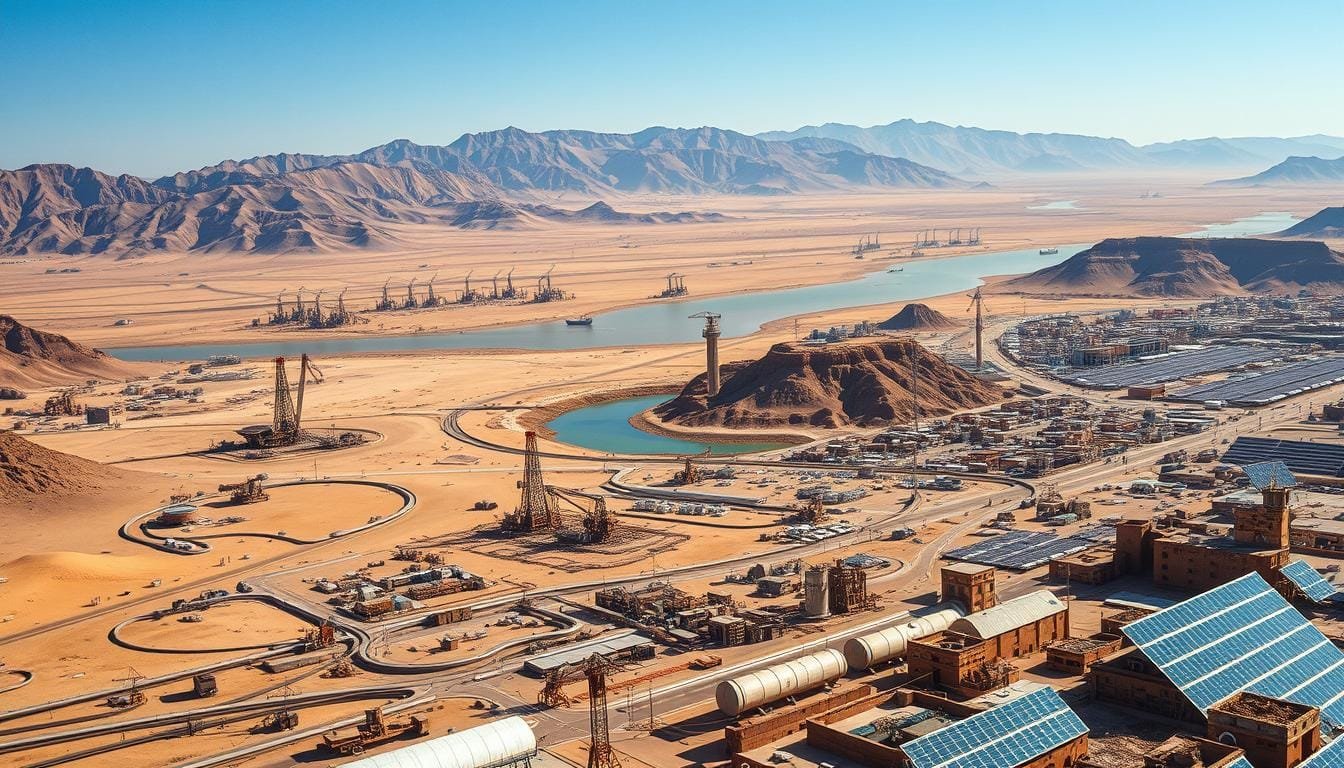The economy of SWW Asia heavily relies on oil’s influence. We see a complex relationship between economic growth and oil prices in the region. This interaction is affected by the global oil market’s ups and downs. Not only that, this situation is tied to changes in the U.S. dollar value and interest rates.
This all impacts the area’s financial health. Looking into oil’s role in SWW Asia, we notice how it affects economies. By examining how oil prices, exchange rates, and interest rates are connected, we can understand their impact. SWW Asia’s growth has significantly been shaped by oil. Our study is supported by a lot of research and data.
Key Takeaways
- SWW Asia’s economic landscape is heavily influenced by the dynamic of oil prices and energy sector growth.
- Global oil market shocks, U.S. dollar value, and interest rates are interlinked with SWW Asia’s economic development.
- Empirical data, such as structural VAR analysis, offers insights into the causal relationships affecting the energy sector.
- Technological advancements and environmental considerations are increasingly pivotal in shaping the region’s energy sector.
- Research on sustainable solutions such as hydrogen energy and solar power is steering the region towards a more diverse energy portfolio.
- Understanding these complex interdependencies is key to forecasting the economic impact of the energy sector in SWW Asia.
Introduction to Oil’s Role in SWW Asia’s Economy
Oil has played a key role in SWW Asia’s economy. Its discovery was a turning point, leading to rapid economic growth. This resource has been essential for energy and has shaped the petroleum industry history.
The Historical Context of Oil Discovery in SWW Asia
Oil was found in SWW Asia decades ago. This wasn’t just about finding oil; it started a time of huge economic change. The area’s large oil reserves brought in investments from around the world. This helped build a strong industry.
Oil’s Initial Economic Contributions and Growth Trajectory
The oil sector initially boosted SWW Asia’s local economies. This happened through foreign investments and new jobs. Over time, the oil industry’s role in economic growth increased. This set the stage for wide-scale industrial development.
Oil revenue helped SWW Asia shine on the global stage. This included better infrastructure, more industrial activities, and higher living standards.
The table below shows important data on oil’s economic impact in SWW Asia:
| Year | Oil Production (Millions of Barrels) | GDP Growth Rate (%) |
|---|---|---|
| 2000 | 120 | 4.5 |
| 2005 | 150 | 5.2 |
| 2010 | 175 | 6.0 |
| 2015 | 200 | 6.5 |
| 2020 | 225 | 3.0 |
The data shows oil production growth and rising GDP. This highlights oil’s crucial role in SWW Asia’s economy. These insights prove oil’s importance in shaping the economic future of SWW Asia.
How Has Oil Impacted the Development of SWW Asia Economically
Oil greatly influences Southwest Western Asia’s (SWW Asia) economy. This goes beyond energy production. It involves GDP growth, job creation in the oil sector, and infrastructure improvements.
Influence on GDP and Economic Expansion
GDP growth in SWW Asia has jumped thanks to oil. Oil production and exports have built a strong economy. This has brought wealth and more investments. Oil profits have helped not just the GDP but other sectors too.
Employment Opportunities Stemming from the Oil Industry
The oil industry has created many jobs in SWW Asia. Jobs range from direct oil work to support roles. This has helped lower unemployment and stabilize the economy.
Oil Revenue’s Role in Financing Infrastructure Development
Oil revenues have funded big projects in SWW Asia. These include roads, hospitals, and schools. These projects improve connectivity, health care, and education, boosting social and economic growth.

| Country | Known Oil Reserves | Impact on GDP (Annual Growth) | Employment Increase in Oil Sector |
|---|---|---|---|
| Saudi Arabia | Approximately 25% of World’s Proven Oil Reserves | 7% | 15,000 jobs annually |
| Kuwait | Almost 10% of World’s Known Oil Reserves | 4.5% | 8,000 jobs annually |
| United Arab Emirates | Substantial Reserves | 6% | 10,000 jobs annually |
| Qatar | Significant Reserves | 9% | 6,500 jobs annually |
The table shows oil’s big role in SWW Asia’s economy. It is key for continuous growth and development in the area. Utilizing oil wealth wisely remains important.
The Double-Edged Sword: Oil Price Volatility and Economic Stability
In SWW Asia, the boom from oil has its downsides, especially with oil price volatility. This issue is a big threat to economic stability, especially with worldwide financial turmoil, like in 2008. The ups and downs in oil prices can really affect countries’ economies and the oil sector.

Oil prices can speed up or slow down economic growth in many areas. This affects jobs, how much people spend, and government money plans. High or low oil prices change the future of countries that depend on this resource. For example, in 2008, a big drop in oil prices cut down production and slowed growth in SWW Asia.
Looking at recent studies shows how important it is to manage oil prices well. Leaders in oil production try to handle the ups and downs by improving how they work and using new tech like AI and the Internet of Things. These steps help keep businesses going, save jobs, and support local communities.
| Year | GDP Growth Rate | Impact of Oil Price Volatility |
|---|---|---|
| 2008 | Negative Growth | High volatility due to global financial crisis |
| 2009 | -2.4% | Continued effects of low oil prices on newly industrialized economies |
| 2010 | 10% (Projected) | V-shaped recovery anticipated with better oil price management |
We see how dealing with oil price fluctuations is key for economic stability in tricky markets. Smart policies and new business approaches can lessen the bad impacts of oil price changes. This ensures ongoing growth and prosperity in SWW Asia.
Strategies SWW Asia Countries Are Implementing to Mitigate Economic Risks
SWW Asia countries are tackling economic risks posed by their oil dependence by adopting smart strategies. They are enhancing energy diversification, building strategic petroleum reserves, and forging strong international energy partnerships. These initiatives aim to strengthen the region’s economic stability.
Investment in Alternative Energy and Diversification Efforts
To combat economic risks from oil dependency, SWW Asia is embracing alternative energy. Investments are flowing into renewable energy projects like solar, wind, and bioenergy. These efforts not only diversify the energy supply but also support global sustainability targets.
Policies for developing renewable energy technology are improving across the region. These policies aim to boost energy security and economic resilience.
Development of Strategic Petroleum Reserves
Strategic petroleum reserves act as safety nets against oil market shocks, ensuring energy access during disruptions. SWW Asia is expanding these reserves, a key move to protect their economies from global oil price swings and maintain steady energy supply.
International Partnerships and Trade Agreements
Forging strong international energy ties is critical for stabilizing SWW Asia’s energy sector. Through trade agreements and international protocols, these countries gain better terms and diversified supply sources. This approach reduces risks and elevates SWW Asia’s global energy market presence.

Alongside these strategies, SWW Asia is engaged in global discussions about resource management. A detailed report by the World Water delves into governance, economic strategies, and international collaboration for effective water and energy resource management. It shows how closely water and energy sectors are linked.
| Country | Renewable Energy Investments | Strategic Petroleum Reserves (Million Barrels) | Key International Energy Partnerships |
|---|---|---|---|
| Country A | $5 billion | 50 | Country X, Y |
| Country B | $3 billion | 30 | Country Z, W |
| Country C | $4.5 billion | 45 | Country V, U |
Through these strategic steps, SWW Asia is not just addressing its immediate economic issues. It is also building a solid base for long-term growth and stability against future global economic changes.
Conclusion
Oil has been key in shaping the economy of SWW Asia. This region has seen big economic growth thanks to its oil resources, especially near the Persian Gulf. The relationship between oil distribution and economic growth shows oil’s big impact. It’s clear oil has helped SWW Asia reach its current global economic status.
SWW Asia’s connection with big groups like the Organization of the Petroleum Exporting Countries (OPEC) shows its economic value. But with oil prices always changing, it’s crucial to look ahead. We need to focus on new energy strategies. These include investing in people, new businesses, and tech. These steps can make the economy stronger and less affected by oil price changes.
Looking ahead, SWW Asia could keep growing economically. This growth could come from better trade, higher living standards, and more investments. Improving these areas and working closely with other countries will help. It will make the most of oil benefits while prepping for a future that prefers clean and flexible energy sources.
FAQ
How has the discovery of oil impacted economic development in SWW Asia?
The discovery of oil in SWW Asia sparked significant economic growth. It led to vast improvements in infrastructure. The region has become a key global energy supplier.
What is the relationship between oil prices and economic growth in SWW Asia?
Oil prices directly affect SWW Asia’s economies. Higher oil prices boost GDP growth due to the region’s reliance on energy sector income.
How have oil supply and demand shocks affected SWW Asia’s economy?
Supply and demand shocks in the oil market impact SWW Asia’s economy. They cause oil price fluctuations. This affects economic stability and real interest rates in the region.
In what ways has the oil industry contributed to employment in SWW Asia?
The oil sector is a major job creator in SWW Asia. It offers jobs in exploration, production, and beyond. This boosts economic growth and workforce development.
What measures are being taken by SWW Asia to address the volatility of oil prices?
SWW Asia is diversifying energy sources and building petroleum reserves. They use international partnerships to stabilize prices and strengthen economic resilience against oil volatility.
How does oil revenue support infrastructure development in SWW Asia?
Oil revenue aids in building infrastructure in SWW Asia. It funds transportation, urban projects, and energy initiatives. These projects further economic growth.
What role do international partnerships play in SWW Asia’s energy strategy?
International collaborations secure stable oil markets for SWW Asia. They support steady supplies and favorable prices. They also facilitate technology exchanges.
How is SWW Asia working towards energy diversification?
SWW Asia invests in renewable energy like solar and wind. The region aims to decrease oil dependence. This promotes sustainable development.
What is the economic outlook for SWW Asia given the fluctuating nature of oil prices?
The outlook for SWW Asia remains cautiously optimistic amid oil price fluctuations. Strategic planning and reforms aim to foster a stable, resilient economy.
